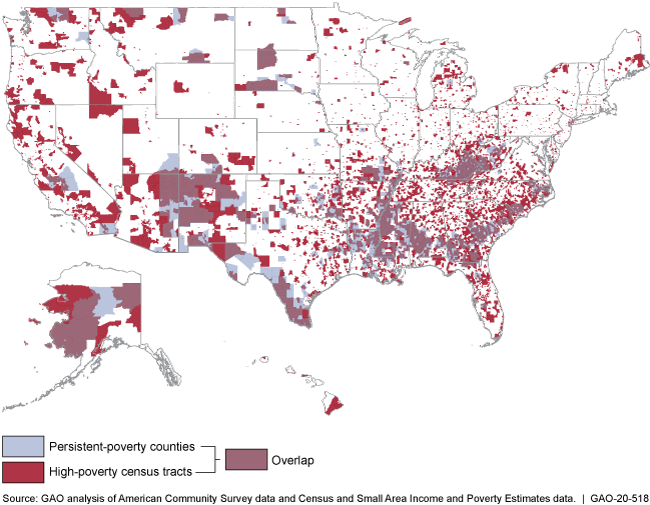Targeting Federal Funds: Information on Funding to Areas with Persistent or High Poverty
Fast Facts
To focus more federal funds on counties with persistent poverty, some federal programs have been required to spend at least 10% of their budgets in these counties. A 2019 bill proposes expanding this requirement to more federal programs and proposes spending requirements for high-poverty Census areas.
We looked at data from USAspending.gov for programs that may be included in this bill. The programs with sufficient county-level data spent about 8% in persistent-poverty counties in the past 3 years—so the bill may increase such spending if passed.
High-Poverty Census Areas and Persistent-Poverty Counties, as of 2017

map
Highlights
What GAO Found
As of 2017, persistent-poverty counties were predominantly rural and more frequently located in the South than in other regions. GAO identified 409 persistent-poverty counties (13 percent of all counties), roughly 50 percent of which were rural. In contrast, high-poverty census tracts—which represented 28 percent of all census tracts—were frequently urban (74 percent). Publically reported federal spending data do not include census tracts. GAO determined that ZIP codes were the best available substitute, and 77 percent of high-poverty ZIP codes overlapped with a high-poverty census tract.
Persistent- and High-Poverty Geographic Areas

Of the 247 programs potentially subject to H.R. 2055, 114 (accounting for $87 billion in spending) had sufficiently complete county-level data in USAspending.gov. In fiscal years 2017–2019, agencies used 8 percent of funds in persistent-poverty counties under these programs (see fig. below). Individual agencies’ funding levels varied, but agencies used less than 10 percent of funding in persistent-poverty counties under 68 programs (60 percent of programs with sufficient data). This included 27 programs that did not have any funds used in these areas. Fewer programs had sufficiently complete ZIP code-level data (46 programs, accounting for $4.9 billion in spending), but agencies used higher percentages of funds in high-poverty ZIP codes (37 percent) under these programs.
Persistent-Poverty County and High-Poverty ZIP Code Funding for Programs Subject to H.R. 2055, 2017-2019

Why GAO Did This Study
The “10-20-30 formula” has been applied to appropriations for some federal programs since 2009. It requires that agencies use at least 10 percent of designated program funds in counties that have had poverty rates of at least 20 percent over the last 30 years (also known as “persistent-poverty counties”).
Legislation proposed in 2019 (H.R. 2055) would apply the formula to more programs for funds appropriated over the next 10 years. It also would require these programs to increase funding in “high-poverty areas”— census tracts with a poverty rate of at least 20 percent over the last 5 years. GAO identified 247 programs across 14 agencies that may fall within the scope of this bill.
GAO was asked to review federal funding allocated to persistent-poverty counties and high-poverty areas. This report examines (1) characteristics of areas with persistent or high poverty, and (2) the percentage of funds that programs included in H.R. 2055 used in persistent-poverty counties and high-poverty areas in fiscal years 2017-2019.
GAO analyzed Census data and publicly reported federal spending data in USAspending.gov.
For more information, contact William Shear at (202) 512-8678 or shearw@gao.gov.
